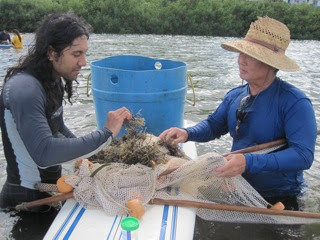 Daniel, Erin, and Aukai are finding shrimps and crabs
Daniel, Erin, and Aukai are finding shrimps and crabsDaniel, Erin, 和Aukai 正在寻找虾和螃蟹
Aukai正在收集MPB样品
实习生们在Sherril和Judy的指导下正在滴定水样品
Sherril正在给实习生讲课
看我帅么?
这些是我们找到的小虾
这是一种我们很久都没有再见过的水藻
我为什么会在你的手里?我很生气,快放我下来!
实习生们正在从水里打捞水藻以便寻找小虾和小螃蟹
Sam: No, I don't think so.
Aukai:这个是我们需要找的吗?
Sam:不是,我不觉得是。
Erin: No way, throw it away.
Daniel:我希望我能从这堆东西里找到什么。
Erin:别做梦了,快把它扔了吧。
MPB样品
Tuesday's afternoon was an awesome time since we both did Megsie's isotop research and Sherril's dissolved oxygen laboratory work together.
上个星期二的下午是一个非常奇妙的下午因为我们同时完成了Megsie的同位素跟踪测定研究和Sherril的溶解氧气的实验测定工作。
Site B was the last isotop site that we went to. As usual, we took plankton samples, MPB samples, limu samples, and shrimp and crab samples. Site B was the nearest site to the dock, and it was close to mangrove forest onshore. The sediment at this site was more rigid than any other site where we could not easily get our feet out of the ground when we were standing. In terms of collecting different samples, we took MPB that were floating on the surface of the water instead of diving down with snorkels and masks because it is hard to get MPB samples on the bottom of the pond, and the concentration of MPB from bottom is also very low. Therefore, under Megsie's new protocol, surface MPB samples were collected.
B区是我们去的最后一个同位素样品收集区了。与以往相同,我们收集浮游生物样品,MPB样品,水藻样品,以及小虾小螃蟹样品。B区是最靠近我们上岸地点的收集区了,它也是靠近生长在岸边的红树林的地方。这个地方的土质比其余3个样品收集区都要稍微地硬一些。因为在其他3个地方当我们要移动的时候,我们很难将双脚轻易地从泥土中拔出来。在这次的样品收集过程中,我们没有带着呼吸管和泳镜下潜到底部去收集MPB样品,而是只收集漂浮在水面上的样品。这是因为在水下收集样品我们看不清周围情况,而且收集上来的MPB样品又很少。所以在Megsie更改了实验方案后,我们只需要收集水面上的MPB就可以了。
Collecting massive limu from the fishpond and finding glass shrimps and blue pincher crabs is always the most exciting part of this research. It is because we can find many more intereting creatures than we what we really want------sounds like treasure hunting :) !! Since it was really a pain in the butt that we did not find many shrimps under the hot sun, we bet our luck on this last site. Fortunately, we found many shrimps at Site B---Thanks God! We even trapped a small puffer fish that was ballooned up!!!!! hahaha!
将大量的水藻网出并寻找小虾小螃蟹永远都是这个研究当中最另人兴奋的时候。因为除了实验需要的虾和螃蟹,我们往往还能找到许多有意思的生物,就像是在池塘中寻宝一样!由于上个星期我们在毒辣的太阳底下找了很久都没有找到特别多的小虾,我们将我们的运气全部押在了这最后的样品收集区。幸运地是,我们找到了许多小虾,感谢上帝!我们也发现了一只鼓得像气球一样的刺豚鱼。哈哈哈!
After we collected all the samples for Megsie's isotop research, we chose 4 different sites to collect water samples for Sherril's dissolved oxygen lab research. I went all the way into the mangrove forest to collect one sample. Honestly, the water inside the mangrove was colder than outside, and I had to be extremely careful while quickly since I did not want to stir up much sediment and encounter some "residents" inside the mangrove like big Samoan crabs. Daniel collected another water sample outside of the mangrove forest, Erin collected one sample inside the moi pend, and Sam collected the last sample outside of the pend. We wanted to investigate the dissolved oxygen inside the moi pend because a few years ago many small moi fish inside the pend died, and we wanted to know if it was because of the lack of oxygen.
当我们把Megsie所需要的所有样品收集完毕后,我们在池塘里选择了4个不同的区域来收集水样品,以便Sherril研究氧气溶解量。我进入了红树林内部去收集第一个样品,说实话里面的水温要明显地比外面低。我必须既小心有快速地完成样品收集工作因为我不希望自己绞起泥沙进入样品当中,更不希望自己碰到诸如大型萨摩亚螃蟹之类的动物。Daniel在红树林的外边收集了第二个样品,Erin在小鱼养殖区内部收集了第三个样品,Sam在其外边收集了最后一个样品。我们测定小鱼养殖区内的含氧量是因为在前些年一些鱼在这个地方死掉了,我们想了解一下那些鱼的死亡是不是由于缺氧造成的。
When we went back to the dock, Sherril had already set up a field laboratory and been waiting for us. After Sherril gave the interns a brief introduction of laboratory safety and how to use the pipets, the interns were split into two groups and began the titration. After 4 water samples had been processed, we found out that the dissolved oxygen inside the pend was more than that outside. Normally, since many fish are living in the pend and consuming oxygen, the value should be less than outside. We guessed maybe it was because we only took one sample at each site and the one outside of the pend was collected at the downstream. Hereby, more samples should be collected, and more titration should be done to draw a finial conclusion.
当我们回到岸上的时候,Sherril已经准备好了一个野外实验室并且正在那里等着我们呢。在Sherril对实习生简单地讲解了有关实验安全和如何使用移液管之后,实习生们分成了两组进行氧气溶解量的定性滴定实验。在所有的4个样品都被处理完毕后,我们发现养殖区内部水中的含氧量要高于外部。在正常情况下,因为养殖区内部有鱼需要呼吸,其水中的含氧量应该低于外部,我们猜想造成这种现象出现的原因有可能是因为我们样品收集的数目过少,而且在养殖区外部收集的样品来自水流的下风向。这也意味着在收集更多的样品和进行更多的滴定实验后我们才能下最终的定论。











No comments:
Post a Comment
Note: Only a member of this blog may post a comment.